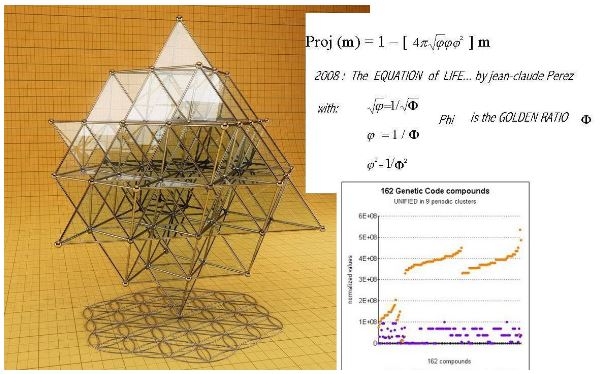Thought this seemed like classic fringe science/new age delirium. But now Luc Montagnier is putting his name to it. Not that Montagnier hasn’t been discredited by mainstreamers already for his heretical work on the memory of water following up on Benveniste.
If true-ish, implications for human meddling in genomes? But is it just a cool fancy meta-map for thinking about complexity across all scales of biology, or is it disprovable as a formal hypothesis?
“The discovery of a simple numerical formula for the projection of all the atomic mass of life-sustaining CONHSP bioatoms leads to the emergence of a set of Nested CODES unifying all the biological, genetic and genomic components by unifying them from bioatoms up to ‘to whole genomes. In particular, we demonstrate the existence of a digital meta-code common to the three languages of biology that are RNA, DNA and amino acid sequences. Through this meta-code, genomic and proteomic images appear almost analogous and correlated. The analysis of the textures of these images then reveals a binary code as well as an undulatory code whose analysis on the human genome makes it possible to predict the alternating bands constituting the cariotypes of the chromosomes. The application of these codes to perspectives in astrobiology and the emergence of binary codes and regions of local stability (voting process), whose fractal nature we demonstrate, is illustrated. The fundamental discovery described here will undoubtedly one day constitute a new biomathematic approach to the emergence of living things.”
— Jean Claude Perez & Luc Montagnier
https://www.granthaalayahpublication.org/journals/index.php/granthaalayah/article/view/4191#
PDF: https://www.granthaalayahpublication.org/journals/index.php/granthaalayah/article/view/4191/4332
1.INTRODUCTION
Beyond its appearance, the major subject of this article will not concern biology, genetics or genomics, but rather the question of the emergence of COMPLEXITY, in the line of research like those of Ilya Prigogine, Benoit Mandelbrot or John Nash.Chapman (n.d.), Mandelbrot (1967), Nash (1964)
Indeed, the central question will be that of the emergence of “regularites” from an apparent disorder. The best illustration is that of the emergence of Benard’s cells Chapman (n.d.), putting organization way from the balance of billions of atoms, or the Mandelbrot’s question “How Long Is the Coast of Britain?” Mandelbrot (1967). Thus we will demonstrate how a binary code can emerge from the apparent disorder of DNA at the level of the entire human genome. We will also show how the living processes constituting the biosphere organize the proportions of the different atomic masses mono-isotopic of the same atom (oxygen for example) then produce the “regularity” of the average atomic masses which prove to be optimal with respect to the code of the “atomic masses code” discovered here (§Methods Atomic code -I-). Twenty years ago, in 1997, it was a kind of “scientific aesthetic sense” that motivated the following research: we found it abnormal that life needed 3 languages to code the information of the living: DNA, RNA, and amino acids, language of proteins … this luxury of redundancy seemed illogical to us, if only because of this famous maxim “All that is simple is false, all that does not is not is unusable “. Others will say “small is beautiful” … We could add “all that is simple is beautiful” … It is true that from 1990 we demonstrated how the Fibonacci numbers – key esthetic of the nautilus, the pineapple or pine cones – structured the DNA sequences of genes (Marcer (1992), Perez (1991)) or small genomes such as mitochondrial DNA [Perez (2017)]. We were looking for a smaller common denominator for DNA, RNA, and amino acids; we have the intuition of the need of 3 “ingredients”:
•The atomic mass and the bioatoms C O N H S P are common to these 3languages.
•The 2 universal constants PI and Phi could play a role.
•Finally, we imagine a kind of digital “projection” (such as those of the cosine or the sinus in geometry), projection which would constitute a kind of “shadow” projecting on the 2D horizontal plane the image of a kind of complex “meta-code” common to these 3 languages….
…




